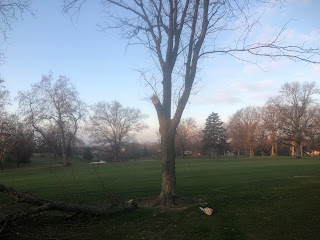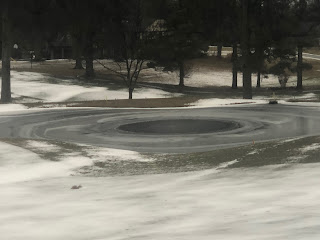It has been a roller coaster ride of temperatures so far this season. This El Nino winter started with a dry and mild December, followed by a very cold stretch in January, then a decent amount of rain ushered in a mild February. After a brief cold snap, the end of this month looks very warm. However, according to Dr. Judah Cohen, Climatologist with Atmospheric and Environmental Research, there could be some colder air moving in thanks to a polar vortex split in late March. Confidence in long range forecasts are the same as flipping a coin, so we will see if this materializes.
Except for the 10 day cold stretch in January, this winter has been well above normal. One temperature trend that seems to be occurring more frequently is warm overnights. Even when the day time highs are close to normal the lows only dip down a couple degrees. There have been many days with highs in the mid 30s and lows just above freezing. Consequently, this has led to higher soil temperatures and some of the plants are already starting to bloom. According to the growing degree day tracker from Ohio State, our area already has 30 GDDs. At 34 GDDs the silver maples (the first plants to bloom in the spring) begin to flower and, right on cue, we are seeing maple trees put out flower blossoms. If this trend continues, the daffodils will soon follow and the spring time tulip display may peak earlier than expected. Another trend that seems to be occurring frequently is colder springs so we will see what kind of temperature ride is heading our way.
 |
| Beautiful sunrise on a warm winter day. |
 |
| The golf course thawing after the mid January cold snap |
 |
| Red maple flower buds |
Verticutting
The warm winter has allowed the agronomy team to get a head start on some important spring projects. Verticutting fairways has been completed about a month earlier than usual. This practice was implemented in 2021 with a Weidenmann Triple V verticutting unit that has helped decrease the thatch layer and reduce compaction in the fairways. Verticutting consists of vertical rotating blades, which penetrate the surface at a depth up to 1". A significant amount of organic matter is brought up and picked up with a TC-125 John Deere sweeper. This procedure will help with the health of the fairway turf and create firmer conditions during the golf season. Tees were also completed.
 |
| Verticutting # 1 fairway with the weidenmann triple v. |
 |
| Emptying out the thatch picked up from the John Deere TC-125 |
 |
| Verticutting tees |
 |
| #4 tee after verticutting |
Driving Range
Some questions have emerged about the driving range rotation/policy. Some of the most frequently asked questions are as follows:
When will the driving range grass open for the season?
The practice tees will open on April 1st starting on the north tees, switching to the south tee in mid May and moving back to the north tees after Labor Day. After November 1st the grass on the practice tee is closed and it is mats only.
Why can't we use the grass during warm days in the winter?
As the temperatures cool the healing time takes longer. In the winter, germination has ceased and the grass' growth has either shut down or slowed down considerably. Consequently, divots that are made after November 1st will not fully heal until growth begins again in April. Beating up the range in the winter will only lead to poor spring time conditions and will inevitably create poor practice tees for the following golf season.
Why are we still hitting on the mats when the grass is open?
The rotation of the practice tees is 5 days on the grass and 2 on the mats. We need to utilize the mats twice a week because the tees are under sized. Typically, an 18 hole course will have close to 2 acres of turf. Combining all the new WHCC practice tee areas we are still just under an acre. To keep the turf in decent shape, so there is still some green grass to hit off of, we need to use the mats twice a week and allow divots to heal (healing takes around 3 weeks during the warm summer months). One of the mat days is always on Mondays and the second day is rotated between Tuesday, Wednesday, and Thursday so golfers are always hitting off the grass on weekends during decent weather.
 |
| Remember to use the linear divot pattern on the practice tees. This pattern will heal faster than any other divot. |
Lakes
An often overlooked part of our job is maintaining the lakes located on the property. Both lakes have aeration systems, The lake on #7 has a surface aerator and the #14 pond has a subsurface (bubbler) aerator. There are pros and cons to both systems. The surface fountain will oxygenate the water in the first couple feet of the water's surface and a bubbler will oxygenate the entire water column. Because #7 lake is larger and shallower a 2 hp surface aerator was chosen and since #14 pond is much smaller and deeper a bubbler was installed.
By far the most problems we have had is with the #14 pond. Because of its location and small size it gets a lot of fertilizer runoff and organic matter buildup that leads to algae blooms. The water temperature also gets very high during the summer months helping to increase Filamentous algae, Euglenea, and Blue Green algae. To combat this we have been using chemicals to suppress its growth, but we are experimenting with other techniques to help the health of this aquatic system. Last year we began utilizing an organic product that incorporates beneficial microbes and bacteria to metabolize excess nutrients. Also, we have been removing much of the leaf debris that has accumulated along the pond's bank over the fall. This should help decrease the amount of decomposing organic material.
Moreover, the lakes will be stocked with some new fish this year. Fathead minnows will be incorporated into #7 lake to help with the food chain for the small mouth bass. When the pond on #14 was drained in 2018 for the #13 green project most of the fish perished. This year we will introduce some grass carp, bluegill and bass to control insect larvae, frog populations, and invasive plants. These new procedures should keep the lakes clean and healthy for the upcoming season.
 |
| Surface aeration on #7 lake |
 |
| Removing leaves out of #14 pond |
Horticulture/Tree Work
The dying taxus bushes behind #2 tee were removed. We will be replacing these in the next couple weeks with emerald green arborvitaes. Tree work has continued throughout the winter months and is almost completed. The USGA agronomist has finished his tree report and we are discussing with the Green Committee on how best to implement the suggestions. I will update as some of these decisions are finalized.
 |
| Taking down dying red maple by #8 fairway bunker |
 |
| Removing a honey locust causing a double hazard by #9 fairway bunker. |
 |
| Bushes removed behind #2 tee. |
In addition the Grounds Crew has been busy with bunker work, course cleanup, and periodic mowing during this latest warm period. As we move into the early spring daily maintenance routines will take center stage and hopefully the winter projects that we completed will be noticed throughout the 2024 golf season.
Brad Piecuch
Grounds Superintendent
